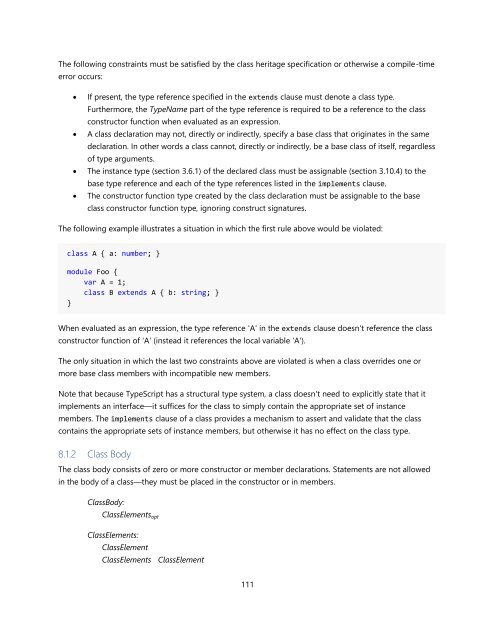TypeScript Language Specification v1.5
TypeScript Language Specification v1.5
TypeScript Language Specification v1.5
You also want an ePaper? Increase the reach of your titles
YUMPU automatically turns print PDFs into web optimized ePapers that Google loves.
The following constraints must be satisfied by the class heritage specification or otherwise a compile-time<br />
error occurs:<br />
<br />
<br />
<br />
<br />
If present, the type reference specified in the extends clause must denote a class type.<br />
Furthermore, the TypeName part of the type reference is required to be a reference to the class<br />
constructor function when evaluated as an expression.<br />
A class declaration may not, directly or indirectly, specify a base class that originates in the same<br />
declaration. In other words a class cannot, directly or indirectly, be a base class of itself, regardless<br />
of type arguments.<br />
The instance type (section 3.6.1) of the declared class must be assignable (section 3.10.4) to the<br />
base type reference and each of the type references listed in the implements clause.<br />
The constructor function type created by the class declaration must be assignable to the base<br />
class constructor function type, ignoring construct signatures.<br />
The following example illustrates a situation in which the first rule above would be violated:<br />
class A { a: number; }<br />
module Foo {<br />
var A = 1;<br />
class B extends A { b: string; }<br />
}<br />
When evaluated as an expression, the type reference 'A' in the extends clause doesn't reference the class<br />
constructor function of 'A' (instead it references the local variable 'A').<br />
The only situation in which the last two constraints above are violated is when a class overrides one or<br />
more base class members with incompatible new members.<br />
Note that because <strong>TypeScript</strong> has a structural type system, a class doesn't need to explicitly state that it<br />
implements an interface—it suffices for the class to simply contain the appropriate set of instance<br />
members. The implements clause of a class provides a mechanism to assert and validate that the class<br />
contains the appropriate sets of instance members, but otherwise it has no effect on the class type.<br />
8.1.2 Class Body<br />
The class body consists of zero or more constructor or member declarations. Statements are not allowed<br />
in the body of a class—they must be placed in the constructor or in members.<br />
ClassBody:<br />
ClassElements opt<br />
ClassElements:<br />
ClassElement<br />
ClassElements ClassElement<br />
111


















